When spore-forming bacteria, such as
Bacillus or
Clostridium, enter a state of starvation, they transform into a state of dormancy in order to survive. No other life form is as difficult to eliminate as the bacteria endospore. Spores are known for their extreme resistances to just about any stress agent or conditions imaginable. The spores themselves are generally of no concern unless they are able to germinate within the human body of if the toxins they produce following spore germination enter the human body. When a spore germinates, it is then transformed into an active vegetative cell that may be able to produce toxins or exhibit pathogenicity. Therefore, understanding the germination and outgrowth of spores is of fundamental importance for prevention of illness.

The spore structure, from the outer to inner layers, consists of the exosporium, the spore coat, the outer membrane, the cortex, the germ cell wall, the inner spore membrane, and the core. The resistance properties of bacterial spores are directly linked to spores’ relatively dehydrated core and surrounding protective layers. When a spore comes into contact with a particular germinant the spore can commit to germination. After spore activation, which most commonly occurs through sub-lethal heat shock, and exposure to a germinant, spores become committed to germination and will continue to germinate even if environmental conditions become less ideal or germinants are removed.
Spore germination takes place without detectable energy metabolism in two stages. After spore activation, protons and monovalent cations are released from the core of the spore and elevate spore core pH. This change in pH is essential for the function of spore enzymes and metabolism. The spore core’s depot of pyridine-2, 6-dicarboxylic acid (dipicolinic acid or DPA) and other divalent cations are also subsequently released from the core. DPA that has been released is replaced by water thus increasing core hydration. In the final germination step, the spore’s peptidoglycan cortex is hydrolyzed, and the core begins to swell due to further water uptake and expansion of the germ cell wall. After sufficient hydration of the spore’s core, protein mobility and enzymatic action returns to the cell. After metabolism returns, spore outgrowth occurs and the spore is converted back into a growing cell.
Spores can survive for long periods of time in food products, particularly in foodstuffs where nutrient content is low or nonexistent. When these spores germinate, food spoilage or foodborne illness can occur. It would be ideal to trigger germination of spores present in the food product prior or during any preservation treatment since spores are much less resistant and more susceptible to inactivation after they have germinated. Although this strategy seems simple, germination rates vary, and a small percentage of spores commonly germinate extremely slowly or not at all after exposure to germinants. Such spores are known as superdormant.
According to
Dr. Peter Setlow, a professor in the Department of Molecular Biology and Biophysics at the University of Connecticut Health Center “The definition of a superdormant (SD) spore is an operational one, and is determined by the conditions used to germinate spore population. Thus under one germinant condition a spore may be SD, but may germinate normally under other germination conditions.” Dr. Setlow is an expert regarding bacterial sporeformers and his research focuses on determining the mechanisms involved in the extraordinary resistance of spores. In an interview with LabRoots, Dr. Setlow emphasized: “The presence of a small percentage of SD spores in populations is probably an example of what is called bet hedging, in that if all spores in a population germinate rapidly in an environment and then the environment becomes toxic, the population disappears. However, if 1% of the population germinates very, very slowly, then when the environment becomes toxic the SD spores will still be dormant and resistant to the toxic environment and won't germinate until the environment becomes permissive for germination and then growth.”

Until recently, studies on bacterial spores have primarily focused on populations and have neglected spores that either fail to germinate or germinate extremely slowly. The development of a simple
method for isolation of SD spores was developed by Dr. Setlow’s research group for spores of
Bacillus subtilis,
Bacillus megaterium, and
Bacillus cereus. This method, called buoyant density centrifugation, separates dormant spores from germinating spores and debris. Dr. Setlow explained “Basically what we did was to germinate spores for several hours under optimal conditions, then physically remove all spores that germinated taking advantage of the fact that dormant and germinated spores have very different densities. This procedure was repeated several times to get relative pure SD spores that germinated very slowly.”

According to Dr. Setlow there are a number of factors that increase the rate of spore germination, including low levels of germinant receptors (GRs) that recognize and respond to normal physiological germinants, as well as the presence and concentrations of germinants in the spores’ environment. Low levels of GRs, located within the inner membrane of the spore, result in spores that germinate extremely slowly. Spores that germinate more slowly or at a reduced rate than the majority of the population, are more likely to survive environmental changes where the majority of germinating spores are inactivated, thus increasing the likelihood of survival for the entire population. “It is not genetic, as if isolated SD spores are germinated artificially and then resporulated, the new spores exhibit the same spread of germination times as did the initial spore population”, Dr. Setlow clarified.
Dr. Setlow explained that SD spores are regarded as a problem for the food industry and a public health hazard “One - Because there are some spores in populations that germinate VERY, VERY slowly relative to the whole population, the strategy of adding a germinant to a food or other product to get any contaminating spores to germinate and thus lose their resistance will not eliminate all spores. It would be impossible to keep samples with added germinant around for long enough to get the SD spores to germinate. Two - Because some spores in populations germinate VERY, VERY slowly, colony formation from such spores will take much longer than for the majority of the population. Thus if SD spores are more resistant to a decontamination agent, perhaps assessment of killing of ALL spores in a food, etc. will require very long incubations of plates used to estimate spore survival.”
Hydrostatic pressure (HP) inactivation studies on
B. cereus and
B. subtilis spores conducted by Dr. Setlow’s group as well as collaborators at the University of Delaware
, using relatively low- and high levels of HP demonstrated almost identical results for both bacterial species.
A more recent study performed by Dr. Setlow’s group in collaboration with the US Army-Natick Soldier Research and Development Center in Natick, MA showed that germination kinetics of
B. subtilis spores during moderate HP (100-400 MPa) and very HP (550 MPa) are dependent upon the level of GRs present within the spores’ inner membrane. Specifically, they found that germination was dependent upon the level of the auxiliary germination protein GerD as well as the transcription factor SpoVT, which modulates levels of GRs. The level of GRs was the most significant factor determining the level of germination in terms of mHP. Germination by vHP was not induced by changes in the level of germination proteins. Instead, reduction of SpoVA protein levels was found to effect germination by vHP which is thought to activate the spore membrane channel made up of SpoVA proteins that is likely opened by vHP. In
another study performed at the University of Delaware, scientists were able to achieve an approximate 1 log reduction of
Bacillus cereus superdormant spores using an aqueous ozone and high pressure-processing hurdle technology.
When asked what important factors his research has revealed involving the complexity of SD spores Dr. Setlow responded “I think we showed that causes of SD in spores could be studied experimentally, and identified one cause of SD. Importantly, we also showed that at the genome level, SD spores are identical to the rest of the population, and that SD spores only differ phenotypically from the great majority of the population.” He explained that there has been limited work regarding the technology available to inactivate superdormant spores in food production and medical settings which indicates that spore resistance agents to various symptoms are generally very similar to those of the starting spore population. Killing treatment still requires a germination step.
Sources:
Foodborne Pathogens and Disease;
Journal of Applied Microbiology;
Current Opinion in Microbiology;
Journal of Bacteriology;













